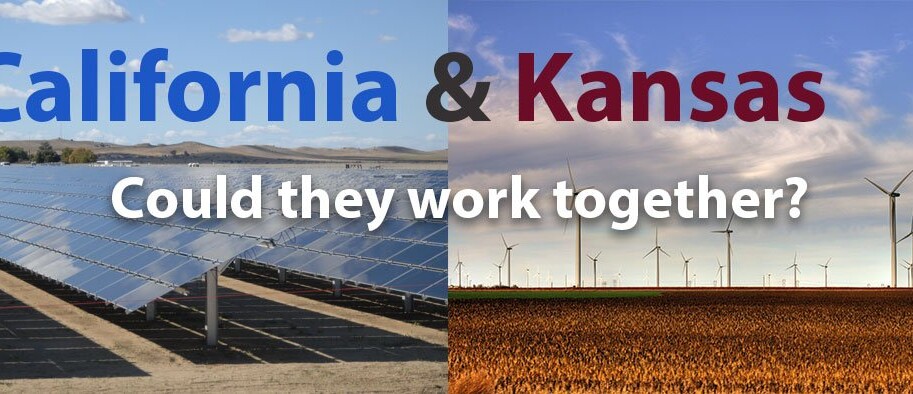The below article by Justin Gillis and Nadja Popovich of the New York Times poses an interesting question in light of “Trump country’s” move toward wind energy: Can blue states help red states move faster toward renewables? Originally titled, “In Trump Country, renewables thrive.”
Two years ago, Kansas repealed a law requiring that 20 percent of the state’s electric power come from renewable sources by 2020, seemingly a step backward on energy in a deeply conservative state.
Yet by the time the law was scrapped, it had become largely irrelevant. Kansas blew past that 20 percent target in 2014, and last year generated more than 30 percent of its power from wind. The state may be the first in the country to hit 50 percent wind generation in a year or two, unless Iowa gets there first.
Some of the fastest progress on clean energy is occurring in states led by Republican governors and legislators, and states carried by Donald J. Trump in the presidential election.
The five states that get the largest percentage of their power from wind turbines — Iowa, Kansas, South Dakota, Oklahoma and North Dakota — all voted for Mr. Trump. So did Texas, which produces the most wind power in absolute terms. In fact, 69 percent of the wind power produced in the country comes from states that Mr. Trump carried in November.
Renewable energy that produces no carbon dioxide emissions is not solely a coastal, blue-state phenomenon. From Georgia to the Dakotas, business and political leaders are embracing clean energy sources even as the Trump administration pushes for more exploitation of oil, gas and coal.
These red states are not motivated by a sudden desire to reduce greenhouse gas emissions. Nor are they joining solidly Democratic New York, Washington and California in defending the Paris climate agreement that President Trump walked away from last week. Instead, their leaders see tapping the wind, and to a lesser degree the sun, as an economic strategy.
The clean energy push allows their utilities to lock in low power prices for decades, creates manufacturing jobs, puts steady money in the hands of farmers who host wind turbines and lures big employers who want renewable power.
“We export lots of things, and in our future, I want us to export a lot of wind power,” Kansas’ conservative Republican governor, Sam Brownback, said in a speech in 2011. “We need more of it, and we need more of it now.”
Mr. Brownback got what he wanted: Since he spoke, wind power production in Kansas has nearly tripled, and the state is now an exporter of clean electricity.
Whatever the motives, the push in the red states does help to lower emissions, which means their goals tacitly align with those of blue states worried about climate change.
So a question is coming into focus: In an era when Washington no longer cares about emissions, could federalism — encouraging each state to pursue its own clean energy goals, for its own reasons — be the way forward for those trying to tackle the climate crisis?
“At the state level, you’re just much closer to democracy,” said Adam Browning, executive director of Vote Solar, a California group pushing clean energy.
In modern America, advocacy of states’ rights is often seen as a conservative stance, an aspect of the right’s general hostility to a large national government. But Michael Kazin, a historian at Georgetown University, pointed out that causes like giving women the right to vote and, more recently, allowing same-sex marriage had often succeeded at the state level first.
“In the American system, the states have enormous powers, which sometimes are used for progressive causes,” Dr. Kazin said.
More than a decade ago, frustrated by federal inaction, climate change activists and clean energy enthusiasts joined forces to push state governments to adopt binding targets for renewable energy. Climate change was a less divisive issue then, and a majority of the states — including many of the windy Great Plains states — did so, often setting targets to be met by 2020 or 2025.
Analysts have found that most states are on track to meet their targets, usually well ahead of schedule. In recent years, the conservative advocacy organizations founded by the industrialists Charles G. and David H. Koch have tried to get the targets repealed, but they have largely failed.
Kansas, where the Koch brothers have their headquarters, was an exception. Reluctantly, wind energy promoters agreed to a deal in 2015 in which the Legislature turned the state’s requirement into a voluntary goal; in exchange, the industry received promises that it would not be subjected to punitive taxes, as some state legislators had proposed. Mr. Brownback embraced that deal but made clear that he expected Kansas to keep building wind farms — as it has indeed done.
Nationally, solar power has made serious headway in a few states, like California, but wind energy is the bigger success story. Turbines now supply almost 6 percent of the nation’s electricity, and studies suggest they could eventually supply a third or more.
A looming threat to the growth of renewables is that the Trump administration may push for an early end to federal subsidies that improve the economics. But those are already scheduled to be phased out in coming years, and a proposal to scrap them early would probably encounter fierce resistance from members of both parties in Congress. They see the subsidies as an investment to drive renewable energy costs down by expanding the market and capturing economies of scale. The wind and solar industries are also creating jobs.
In reaction to Mr. Trump’s election and his abandonment of the Obama administration’s climate goals, Democratic states like New York and California are redoubling their efforts. Both states have resolved to get 50 percent of their power from renewable energy, and California is debating whether to set a target of 100 percent by 2045.
Perhaps the big question now is whether the blue states, motivated by the urgency of climate change, can offer the red states anything that might induce them to move even faster on renewable energy.
One possibility is cash. California and other Western states are discussing linking their electricity markets more closely, which would allow more renewable energy generated in the red states to flow to California consumers — and move California money into the pockets of red-state landowners.
Republican-led Wyoming, the nation’s largest coal-producing state, could be a prime beneficiary, with a proposed wind farm that would be one of the biggest in the world. The governors of Wyoming and California are discussing a deal, though both are nervous about giving up some control of their electricity markets.
Another possibility is that red and blue states could join forces to get power lines built faster. Studies suggest that Kansas alone could, in theory, supply a majority of the nation’s electricity using wind turbines, if enough power lines are available to move it to market.
As renewable energy costs keep falling, the chances for such cooperation between blue and red states will increase. So even as the Trump administration seems to sit out the climate emergency, experts who spend time talking to governors see a way forward.
“I think the answer is that we don’t need these silly wars. Let’s not even try to agree on climate change,” said Hal Harvey, chief executive of Energy Innovation, a think tank in San Francisco. “Let’s just get the job done.”
Source:


